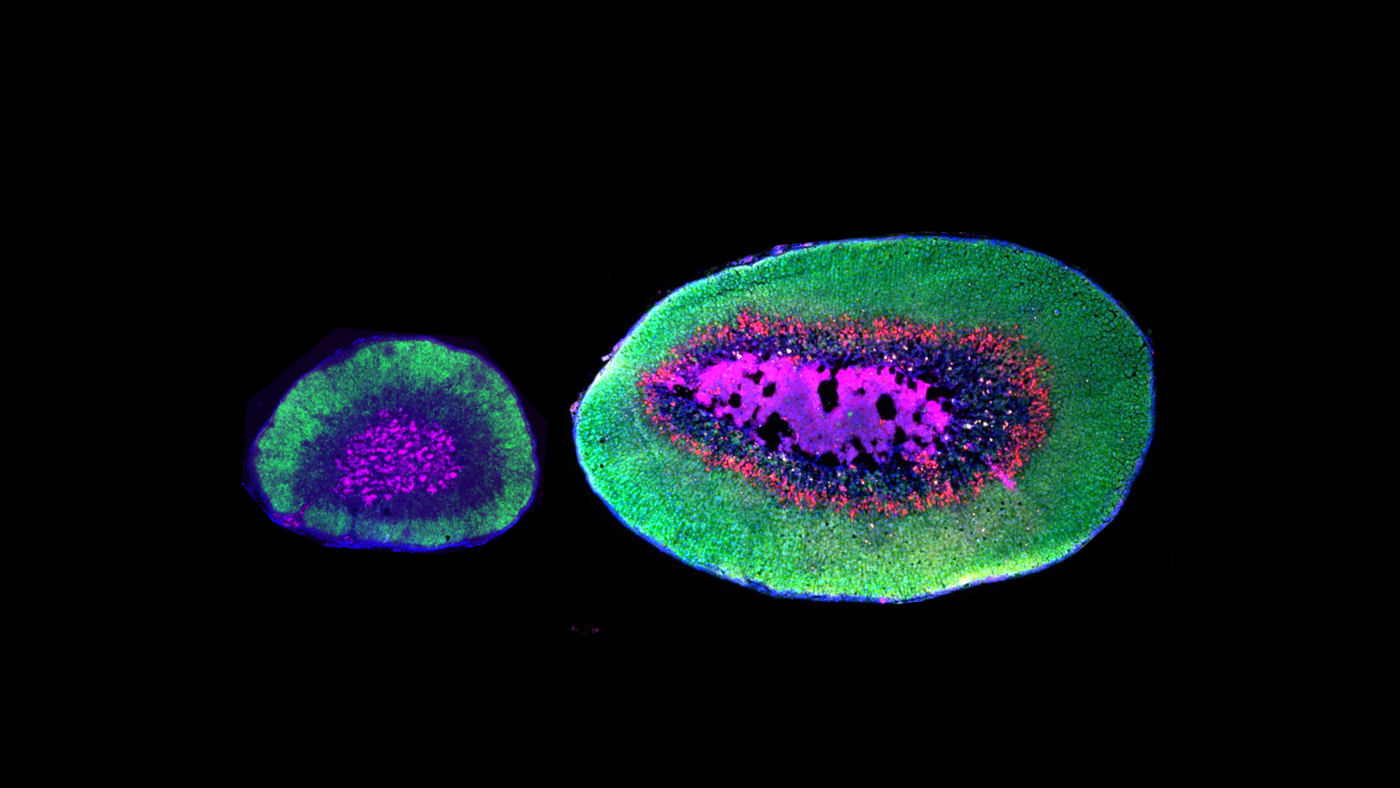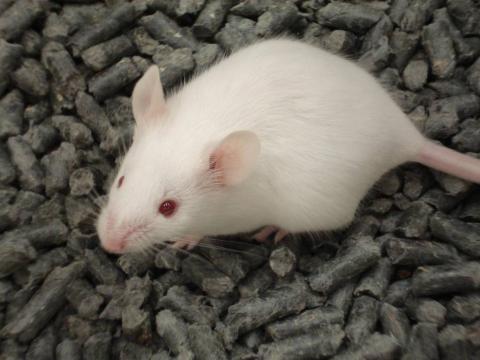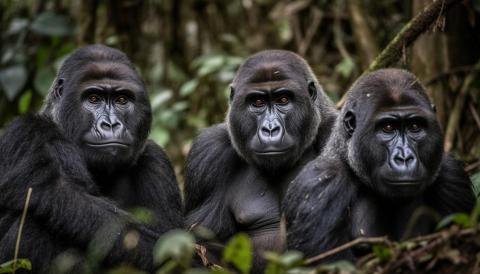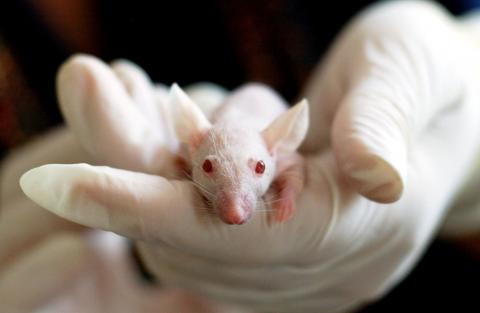New cell type promotes parental care in mice
A research team has discovered a type of cell that appears to be linked to parental care in Oldfield mice, a monogamous species. These cells are not present in Deer mice, other rodents of the same genus that engage in promiscuous behaviour. The results "provide an example by which the recent evolution of a new cell type in a gland outside the brain contributes to the evolution of social behaviour," the authors conclude in their paper, published in Nature.

Aadrenal glands of a Deer mouse (left) and Oldfield mouse (right). Credit: Bendesky lab/Columbia’s Zuckerman Institute.
240515 ratones cuidado parental - Fernando Martínez EN
Fernando Martínez García
Professor of Cell Biology, UP of Medicine of the Faculty of Health Sciences
Director of the Laboratory of Functional Neuroanatomy (NeuroFun)
Professor of the Master's Degree in Brain and Behaviour Research
Member of the Spanish Olfactory Network
Natalie Niepoth and her collaborators at the Zuckerman Mind Brain Behavior Institute at Columbia University (USA) have published a paper in Nature that demonstrates the appearance of a new cell type in the adrenal cortex of the Californian beach mouse, Peromyscus polionotus. The authors attribute to this cell type the biparental (father and mother show parental behaviour) and monogamous character of this species, as opposed to the promiscuous and exclusively maternal character (fathers do not participate in breeding) of other mice of the same genus (P. maniculatus or deer mice). In this sense, this article follows in the wake of the recently deceased Larry Young's study of another genus of American rodents, with biparental monogamous and maternal polygamous species (the genus Microtus).
The work is based on the observation of the large size, in absolute and relative terms, of the adrenal glands of the beach mouse, about 6 times larger than in the deer mouse. The adrenal glands have two functionally distinct parts: the cortex, which produces corticosteroid hormones (derived from cholesterol); and the medulla, which produces catecholamines (adrenaline and noradrenaline). Well, it is in the cortex that the differential size of the adrenals of the beach mouse is found: compared to the deer mouse, the adrenal cortex of the beach mouse is almost 9 times larger and has more cells (almost x5) and is larger in size.
In an attempt to understand the functional consequences of this growth, the authors sequenced the mRNA of the glands to analyse the expression of enzymes involved in corticosteroid synthesis in both species. The experiment reveals in the biparental beach mouse the massive expression (x3200 relative to that occurring in the promiscuous deer mouse) of an enzyme that transforms progesterone into 20-aOHP. This steroid was considered to be an inactive form of progesterone, but the authors propose a link between it and the biparental behaviour of the beach voles.
To test this, they administered a single dose of 20-a-OHP to adult males and females. Twenty hours later, compared to vehicle, 20-a-OHP induced an increase in parental care (nest building, grouping of pups in the nest, licking and grooming of the pups). Even in deer mice (polygamous and non-parental), the steroid increases parental care, suggesting, according to the authors, that increased production of 20-a-OHP was the mechanism of the origin of biparentality in the beach mouse. On the other hand, the administration of 20-a-OHP does not influence the pair bonding characteristic of monogamous species (preference for a partner over another adult), nor does it induce a preference for a partner in promiscuous species. Nor does it alter anxious behaviour (seeking refuge in protected arms, in a raised cross maze).
The behavioural influence of the steroid 20-a-OHP is due to the action of one of its metabolites (allo-pregnanediol or simply allo-diol) on the response of the δGABA-A receptor to GABA, the inhibitory neurotransmitter par excellence, in the central nervous system.
Based on this observation, the authors analyse cell types in the adrenal cortex by massive sequencing of messenger RNA (RNAseq) from individual cells. A cell type is a set of cells characterised because they express a particular set of genes in their genome that give them specific structural, biochemical and functional characteristics. In their RNAseq study, the authors identify a cell type in the adrenal cortex of the beach mouse that is not present in any other rodent studied, and which is responsible for the production of 20-a-OH. These cells occupy a specific layer of the adrenal cortex, never before described, which the authors call the curious name of zona inaudita. In addition to overexpressing the 20-a-OHP-producing enzyme, these cells express specific extracellular matrix glycoproteins (tenascin N) and a group of specific transcription factors.
Finally, the authors carry out a quantitative genetic study on hundreds of offspring of the second generation (F2) of mice hybridised between the two Peromyscus species (the beach mouse and the deer mouse), taking advantage of the fact that they produce fertile offspring. In doing so, they are trying to understand the genetic changes that led to the emergence of this new cell type only about 20,000 years ago in Peromyscus polionotus. Their results indicate that in the inauditory zone there are two distinct clusters of genes whose expression shows a high and significant internal correlation, and therefore must share regulatory mechanisms, one for each cluster, related to specific groups of upstream transcription factors. The authors are able to identify some of these.
Numerous developmental biology studies have shown that the expression of certain transcription factors is critical for the differentiation of specific cell types, suggesting that small genetic variations in non-coding areas of transcription factor genes could be the basis for the emergence of new cell types, a key phenomenon in the evolution of species. This work demonstrates for the first time that this is the case, thanks to the discovery of a new cell type in a particular species of mouse.
The work is very solid, using a combination of anatomical, genetic, histological, behavioural and electrophysiological techniques to identify and characterise a new cell type and understand the genetic mechanisms of this recent evolutionary phenomenon.
It leaves, unsurprisingly, many questions open. We do not understand, for example, how biparental behaviour arises from the synthesis of a new corticosteroid, 20-a-OHP, by a new cell type, the cells of the inauditory zone. We do not know, for example, whether the secretion of 20-a-OHP is regulated by adrenocorticotropic hormone, ACTH, like other corticosteroids, although it stands to reason that it is. If so, the stress phenomenon, primarily activation of the hypothalamic-pituitary-corticoadrenal axis, would be a stimulating factor for parental behaviour, which seems rather counter-intuitive.
Nor is it easily understandable that an inducing agent of parental behaviour would not also be a reinforcer of the pair bonding that characterises biparental species (maternal and paternal behaviour), since these are two behaviours that are inextricably linked in mammals.
On the other hand, the discovery of a new corticosteroid and its active metabolites with low affinity for progesterone receptors and clear behavioural effects constitutes an opportunity for the production of new drugs whose applicability is promising, perhaps in the treatment of parental behavioural disorders, such as postpartum depression or maternal anxiety states. A whole world to be explored.
Natalie Niepoth et al.
- Research article
- Peer reviewed
- Animals



